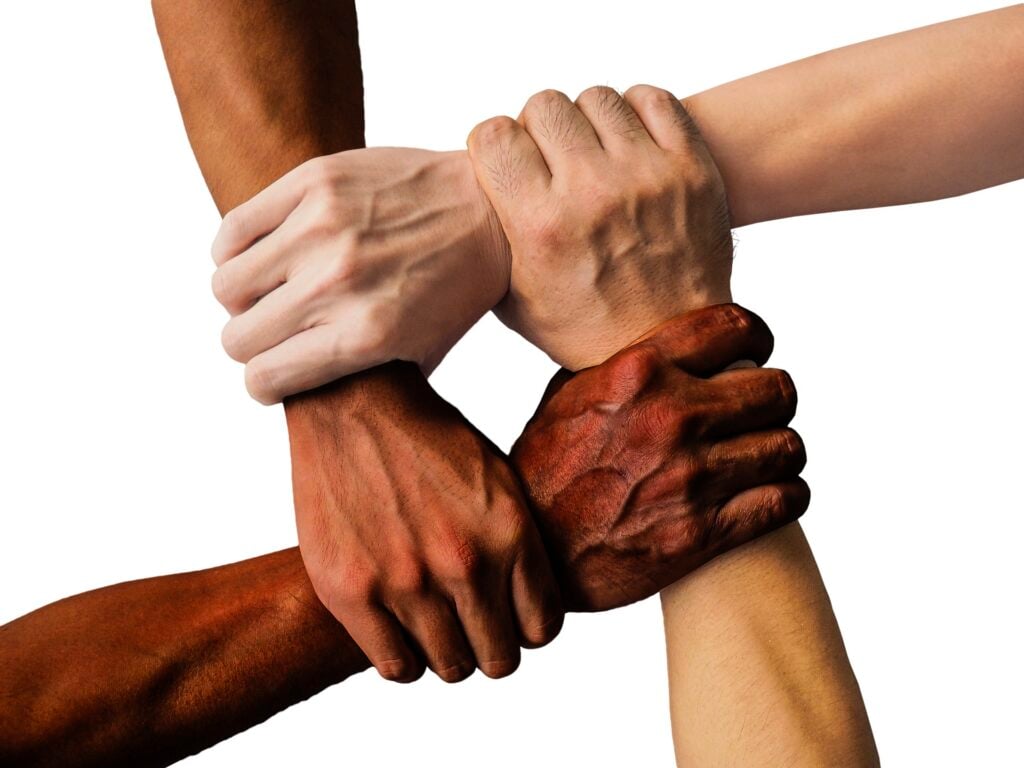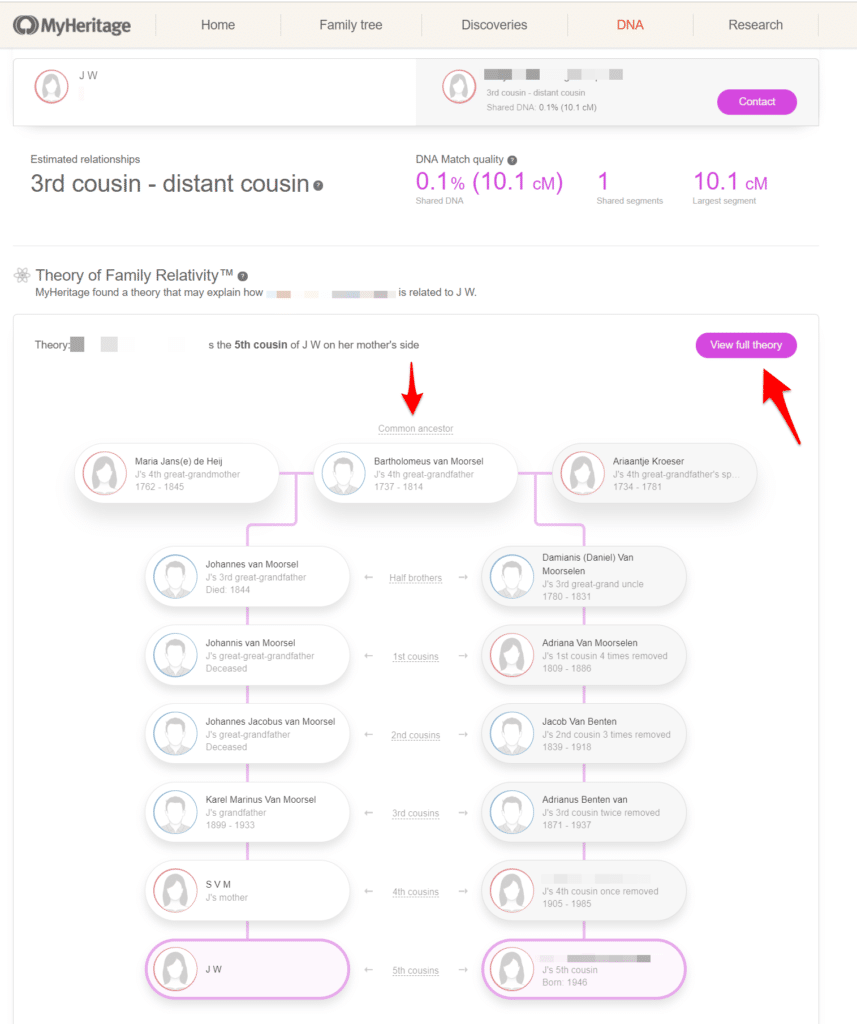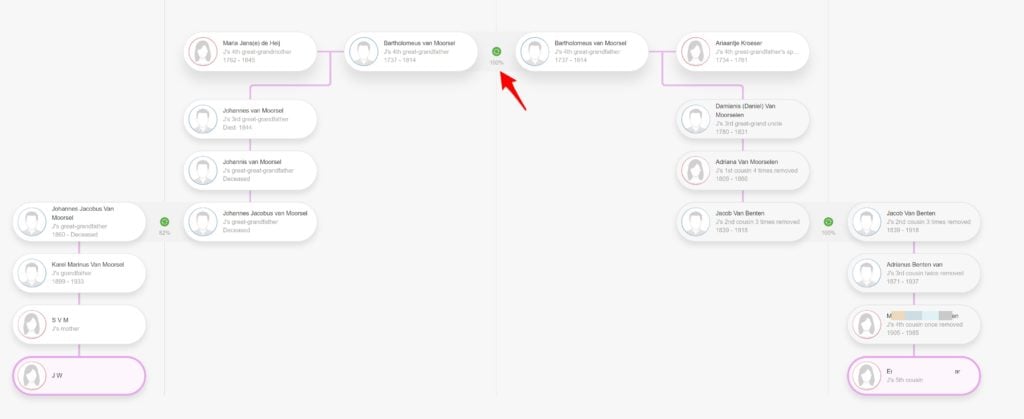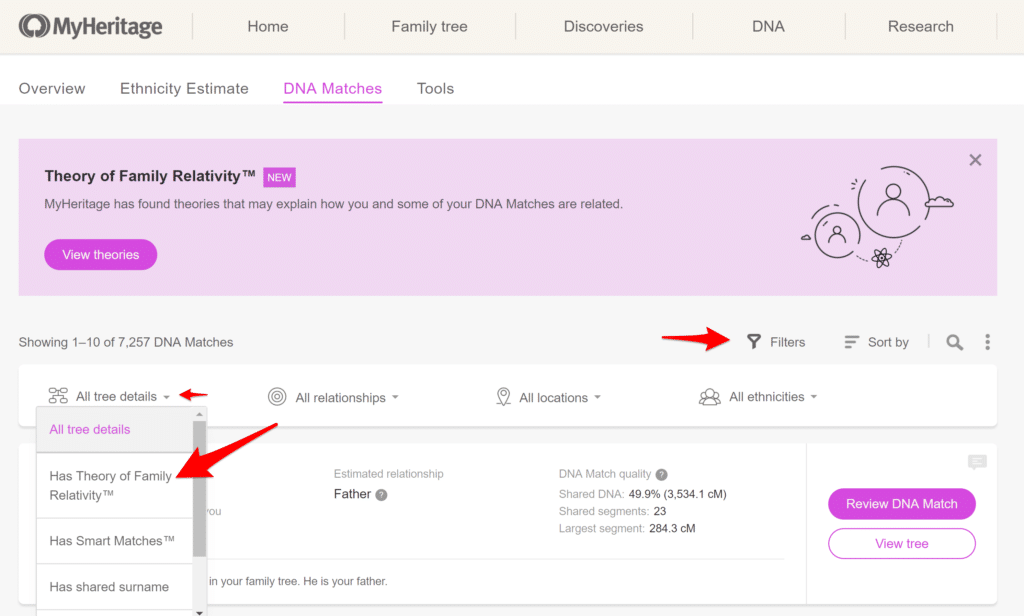MyHeritage has announced a new genealogy tool that will allow its DNA users to more easily discover how they may be related to their genetic matches.
This technology, called the Theory of Family Relativity™, uses family tree information and historical records from a variety of sources to attempt to find and display a common ancestor for matching individuals in the MyHeritage DNA database. These sources include user trees on MyHeritage, the large interconnected trees from Geni and FamilySearch, and historical records.
Please know that we partner with many genealogy companies, including MyHeritage, to bring you information about their services and may receive a fee to support our work if you follow links in this article and decide to take an action or make a purchase.
As MyHeritage explains it:
The Theory of Family Relativity™ is based on a big data graph that connects billions of data points drawn from thousands of databases on MyHeritage, in real time. Every node on this graph represents a person, and every edge depicts a blood relationship between two individuals that is described in a family tree or a historical record; or a match between two tree profiles that are likely to be the same person; or two records that are likely to be about the same person.
MyHeritage already has one of the most practically useful genetic genealogy systems available. When viewing a DNA match a user is able to see what surnames and locations they share with their match (based on uploaded family trees), see shared genetic cousins and view matching DNA segments in the chromosome browser. Additional filtering and triangulation options make for a powerful platform for exploring how two people are related.
They offer these features to those who have tested directly with them, as well as those who have uploaded their DNA from another service – although some require a premium subscription or DNA upgrade for $29.
With this new advancement MyHeritage is leveraging their highly developed genealogy research tools, including billions of historical records, family trees, relationships with third parties such as FamilySearch, and already developed matching technology to help its users bridge the gap between DNA and traditional genealogy research – a concept that will no doubt be a major theme in genetic genealogy moving forward.
How does the Theory of Family Relativity work and is it really useful?
We took some time to explore this new feature on MyHeritage and were immediately impressed with the potential. Although we were disappointed to find that only a tiny percentage of matches had so-called “theories” in our test, we could see how powerful this new tool would be if it could be applied to more people.
Unfortunately, the limited number of theories is tied to the lack of available user data on MyHeritage. A surprising number of people do not upload their family history information when being tested and this makes it hard for any matching technology to work.
This lack of available family tree information is, in part, a reflection of the disconnect many users still experience between DNA and traditional research. While some testers are only interested in a quick glance at an ethnicity report, many others would like to learn more but simply don’t know how to use their genetic information to build their family tree. It’s for this reason that DNA-genealogy tools like the Theory of Family Relativity are so exciting – even if this type of technology is still in its infancy.
For our matches that did have theories, we found that the technology was able to create them using many different strategies. Some were straightforward, a shared ancestor in the trees of two matches – but others were more complex. In several examples, MyHeritage took the information from our test tree and matched it with another person’s public tree that we have never connected to before (genealogically or genetically) and then connected that information to the tree of our match – in essence, splicing the two trees together.
In others, more than one tree was placed in-between our tree and our match’s tree, with the program extending the generations in our own tree backwards and then using that new information to connect with the ancestors of our match.
In many situations more than one “path” for these connections was included – we saw up to 5 on one theory – showing that MyHeritage was able to discover the relationship through many different interconnecting trees.
MyHeritage says about this process:
… a theory that explains a DNA Match between two users can begin in the family tree of the first user, traverse through a series of matching trees into a census record, continue to a household relative, who then matches into another tree, until the path completes with the family tree of the second user. MyHeritage displays the complete path of every theory, and explains every step along the way, allowing the user to verify its accuracy.
An example below shows how MyHeritage used two trees to connect the information provided in one of our test trees to a match from Ireland, via the Netherlands. In the first image you can see the main theory presented on the match’s page.
Clicking on “View full theory” brings up an expanded view of this connection where we can examine just how they reached this conclusion. The green circles with percentages denote the areas that two trees were connected and the confidence of those matches.
This theory is rather elaborate and makes some questionable looking connections to such a distant “cousin” with only one matching segment. It will definitely take some work to see if it proves correct. Most of the other theories we encounters were more conservative.
Could we have discovered some of these connections ourselves using the family trees of our two genetic cousins? Yes. Others would have been much harder to find ourselves. But, the truth is, we can certainly use the help – even in easy cases. As with most DNA testers we simply do not have enough time to explore every match ourselves.
Because MyHeritage shows details about the family site/family tree that the information comes from, we are able to examine that research to see how the information was sourced and whether it appears accurate.
The elephant in the room here, of course, is the fact that almost all of the matching being done in theories is through family trees, and any family historian concerned about accuracy knows not to use family trees as anything more than a tool in their research.
Because so many trees are poorly researched and improperly sourced, it is important to remember that the Theory of Family Relativity must be used with caution. While companies like MyHeritage are developing new tools every year to help us with our research, we must be sure to use the skills we have as researchers to ensure that what we add to our trees is accurate.
Of course, the Theory of Family Relativity is matching you to people who you are (most likely) related to genetically, so this does lend an extra layer of assurance to these connections. But it doesn’t mean that these theories are automatically accurate. Far from it. Examine each one closely and always verify everything with records before adding to your own tree.
The other important thing to take into consideration here is the fact that, although MyHeritage has developed this tool to help you find out how you are connected to your DNA matches, they are not using actual DNA data as part of this system in any visible way. While it seems likely that they are using your predicted relationship range to help find a match in the right generation, it does not appear that they are taking advantage of triangulation of genetic matches, matching chromosomal segments or other genetic information to help develop theories.
This means that the advanced strategies that researchers have developed to determine how two matches are related are not being put to use here. Instead, MyHeritage is harnessing massive amounts of collected genealogy data and applying that to people you match genetically. One day, perhaps, they will find a way to combine both for an even more powerful system.
Another brand new MyHeritage tool, AutoClusters, bunches together individuals by matching chromosomal segments to help you find common ancestors. This tool, which proposes to do something automatically that researchers typically do by hand, will no doubt prove to be an exciting addition to their DNA system and a good compliment to theories. You can read more about AutoClusters on the MyHeritage blog here.
How can I access the new Theory of Family Relativity tool on MyHeritage?
This feature is a premium offering from MyHeritage. Those who have a Premium, PremiumPlus or Complete Subscription, and who have uploaded their DNA or tested directly with MyHeritage, will have access to theories.
To make this tool more accessible MyHeritage is also offering the ability to pay a one-time $29 fee in place of a subscription for those who have uploaded their raw DNA from another testing service and who want access to theories. This fee also includes access to the MyHeritage Ethnicity Estimate and their AutoClusters tool.
It is unclear at this time if those who tested directly with MyHeritage will also have to pay the fee or have a subscription to access the theories.
You can upload your DNA here if you have tested with Ancestry, FTDNA, 23andMe or LivingDNA and would like to use to this new feature. You will receive matches for free and will be asked to pay the fee to access theories and the other features mentioned above.
If you prefer to have access to these features as well as to MyHeritage’s historical records and an unlimited version of their family tree you sign up for a free trial of their Complete Subscription here.
Whether you have a premium subscription or not, theories are easy to spot. MyHeritage is running a large pink banner on the top of all DNA accounts that points users to the new feature. You will also see a theory shown on matches that do have them and you can filter for those people under the All Tree Details filtering menu.
You will see mention of theories regardless of whether or not you have a subscription or DNA upgrade, but will not be able to access them without that premium level.
For more information about using MyHeritage and their tools for DNA and genealogy please see this section of our site.



